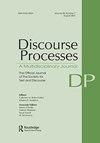Structural repetition in responses to indirect requests
IF 2.1
2区 心理学
Q2 PSYCHOLOGY, EDUCATIONAL
引用次数: 0
Abstract
ABSTRACTWe report three experiments that assess whether structural priming in a question–answer dialogue context is affected by the use of direct requests, conventional indirect requests, and nonconventional indirect requests. In Experiments 1 and 2, experimenters made phone calls to businesses and asked either Can you tell me (at) what time you close? (conventional indirect request) or May I ask you (at) what time you close? (nonconventional indirect request). Structural priming was demonstrated by participants’ greater tendency to produce a preposition in their response (At 9 vs. 9 o’clock) when the question had a preposition than when it did not. The results of Experiments 1 and 2 suggest that priming is not statistically different across request types. In Experiment 3, we compared priming for the conventional indirect requests to priming for direct requests ([At] what time do you close?). Again, priming did not differ across question types. We conducted a final analysis that included data from all three experiments plus a large dataset collected using the same procedure. The larger analysis (n > 43,000) confirmed that priming did not differ across sentence types. AcknowledgmentWe thank the many research assistants who assisted with these studies: Rebecca Applebaum, Samirah Artiste, Haley Barash, Mia Carter, Alathea Fairweather, Matthew Gomes, Karina Guenin, Alex Gutowski, Victoria Kolev, Elizabeth Lacy, Mollie Londot, Jordan Madsen, Jennifer Mast, Casey Oberdick, Maria Ribeiro-Siqueira, Kayla Sizemore, Lindsey Summerlin, Kristen Tinnerman, Jeremiah Townsend, Richard Valencia, Olivia Wentworth-Buchanan, Alyssa Westmoreland, Rachel White, Jordan Wiener, and Ashlyn Young.Disclosure statementNo potential conflict of interest was reported by the author(s).Notes1. We analyzed the data with the following model: Dependent Variable ~ Question Type × Sentence + (1 + Question Type | Experimenter).2. Confidence intervals computed using the confint() function in R, based on the model specified in footnote 1.3. The designation “responded to the direct component of the indirect request” should only apply to the conventional and nonconventional indirect requests. However, there were a small number of cases where participants responded to What time do you close? (a direct request) by saying Sure! We close at 9 (or something similar). These were coded as “1” because the participant provided a yes or no answer before responding to the request for information (even though the question did not include a yes or no component).回应间接请求时的结构重复
摘要本文报道了三个实验,评估了直接请求、常规间接请求和非常规间接请求的使用是否会影响问答对话语境中的结构启动。在实验1和2中,实验者给商家打电话,问:“你能告诉我你们什么时候打烊?”(传统的间接请求)或者我可以问一下你们几点打烊吗?(非常规间接请求)。当问题有介词时,参与者比没有介词时更倾向于在他们的回答中产生介词(在9点vs. 9点),这证明了结构启动。实验1和2的结果表明,启动在不同请求类型之间没有统计学差异。在实验3中,我们比较了传统间接请求的启动和直接请求的启动(你什么时候关闭?)。同样,不同问题类型的启动效应没有差异。我们进行了最后的分析,包括所有三个实验的数据以及使用相同程序收集的大型数据集。更大的分析(n > 43,000)证实了启动在句子类型之间没有差异。我们感谢协助这些研究的许多研究助理:丽贝卡·阿普尔鲍姆、萨米拉·阿提斯特、海莉·巴拉什、米娅·卡特、阿拉希娅·费尔韦瑟、马修·戈麦斯、卡琳娜·盖宁、亚历克斯·古托斯基、维多利亚·科列夫、伊丽莎白·莱西、莫莉·朗多、乔丹·马德森、詹妮弗·马斯特、凯西·奥伯迪克、玛丽亚·里贝罗·西奎拉、凯拉·西兹莫尔、林赛·萨默林、克里斯汀·特纳曼、耶利米·汤森、理查德·瓦伦西亚、奥利维亚·温特沃斯-布坎南、阿丽莎·威斯特摩兰、雷切尔·怀特、乔丹·维纳和阿什琳·杨。披露声明作者未报告潜在的利益冲突。我们采用因变量~问题类型×句子+(1 +问题类型|实验者)的模型对数据进行分析。使用R中的contt()函数计算置信区间,基于脚注1.3中指定的模型。“对间接请求的直接组成部分作出答复”的指定应只适用于常规和非常规间接请求。然而,在少数情况下,参与者会回答“你什么时候关门?”(直接请求)说Sure!我们在9点(或类似的时间)关门。这些被编码为“1”,因为参与者在响应信息请求之前提供了一个是或否的答案(即使问题不包括是或否组件)。
本文章由计算机程序翻译,如有差异,请以英文原文为准。
求助全文
约1分钟内获得全文
求助全文
来源期刊

Discourse Processes
Multiple-
CiteScore
4.30
自引率
4.50%
发文量
27
期刊介绍:
Discourse Processes is a multidisciplinary journal providing a forum for cross-fertilization of ideas from diverse disciplines sharing a common interest in discourse--prose comprehension and recall, dialogue analysis, text grammar construction, computer simulation of natural language, cross-cultural comparisons of communicative competence, or related topics. The problems posed by multisentence contexts and the methods required to investigate them, although not always unique to discourse, are sufficiently distinct so as to require an organized mode of scientific interaction made possible through the journal.
 求助内容:
求助内容: 应助结果提醒方式:
应助结果提醒方式:


